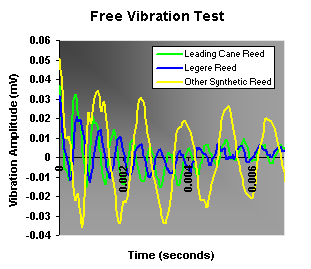| Légère
reeds are made from polypropylene, which is approved by the FDA for use in
direct food contact applications, so our reeds are completely safe to use.
Recently, there has been concern expressed in the media about a chemical
compound called Bisphenol-A (BPA) which is used to make some plastics.
Polypropylene does not contain BPA. Those expressing concern about BPA in baby
bottles often suggest polypropylene as a safe alternative. |
| |
| We process our polymer
in a special way that lines up the molecules themselves in order to precisely
match the stiffness and density of moist cane. We do not add glass fibres or
any chemicals. Some characteristics of our material: |
| |
- It doesn't have to
be preconditioned before playing.
- It does not absorb
water
- It is completely
non-toxic
- It can be
sanitized
- It is extremely
tough and it will last a long, long, time.
|
| Of course, the best
thing about our material is its sound. Even with all of the advantages of a
synthetic, you wouldn't spot our reeds on the stage at the Berlin Philharmonic
Orchestra if the sound wasn't wonderful. |
| |
| The sound of a
woodwind reed is generated when the reed vibrates, opening and closing the
mouthpiece hundreds or thousands of times per second. The reed must be both
stiff and light in order to do this. Reed cane (Arundo Donax) has a combination
of stiffness and low weight that difficult to match in a synthetic material.
Most plastics are not stiff enough and too heavy, and the carbon and glass
fiber composites used in golf club shafts are stiff enough, but generally too
heavy. A heavy reed behaves like a diving board with a heavy person on the end:
it vibrates at a low natural frequency. |
|
| At
Légère we use our own special plastic formulation that has
properties similar to those of cane in the playing condition, i.e. slightly
wet. |
|
 |
| The graph above
illustrates this point with a comparison between one of our reeds, a leading
cane read, and another brand of synthetic reed. For this experiment, the reeds
were all mounted on a mouthpiece with a standard ligature, and a microphone was
mounted in the end of mouthpiece. The reeds were plucked and allowed to freely
vibrate at their natural resonant frequency. The signal from the microphone was
recorded with a digital oscilloscope, and is shown above. |
| |
| The
Légère reed had a resonant frequency and overall response very
close to that of the cane. The other synthetic was too heavy, and vibrated much
slower. You would be able to tell the difference if you played these reeds! The
innovation of the Légère reed is protected by U.S. Patent #
6,087,571. Other Patents pending. |